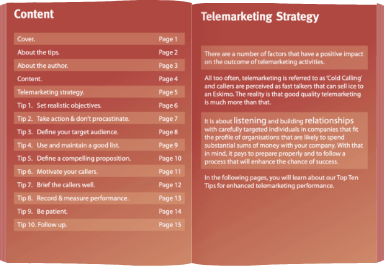Given the nature of my business, I have the opportunity to look at a lot of company websites and to listen to a lot of salespeople. This is either when discussing marketing activity or when running telemarketing campaigns and training.
What strikes me too often is that what I see and hear is fundamentally flawed. Three things are particularly noticeable both on the phone and in other communication:
-
-
- Most communications are about what the company does and what the product or service is.
- Cold callers make calls ‘telling’ the prospect that they’re suppliers of whatever type of products or services and they’d like to introduce these to their company. Websites give detailed and often technical explanations of what those offerings are and do.
- Most marketers mistake features for genuine benefits
-
This is a very common mistake. Sellers talk about features when they mean benefits. For example, Imagine a supplier of work boots. They might declare that their product has fantastic slip resistance but forget to detail that this means that there are fewer accidents in the workplace leading to less downtime, few employee claims, greater productivity, and more bottom-line profit.
Most communication is much more about the seller than the buyer.
This is where it all goes wrong. In simple terms, the buyer is not interested in what you do or what you offer. They don’t care about your products, services, brochures, website, salespeople, or anything else about you or your business. They are interested in what you can potentially do for them. They inevitably have challenges. They have stressed. Some of these are about their business and some pertain to their own job role in the business. Yet, despite this, most communication still focuses on what the company offers rather than explaining how those products or services alleviate some of the challenges that the buyer faces.
If you can demonstrate how you can support the buyer’s role and solve the issue they have through the provision of what you offer, you have a better chance of gaining their attention and of subsequent success.
Does this mean turning everything on its head?
To some extent yes. It depends on what you’re doing now. When prospective buyers reach your website or speak to your sales agent, you need to provide valuable information about how you solve problems. Your communication needs to clarify how you are genuinely differentiated as much as providing information about what you offer. You need to be more like a consultant and facilitator and less like a salesperson. Your website and salespeople need to differentiate themselves as much as your products and services. That means not sounding and looking the same as everyone else. Think customer first.
Consider your own situation. When you’re searching for a new solution, you may ask advice from colleagues or peers in your network and you might also run an online search. You may end up with a long list of potential suppliers. Let’s take the example of a PR agency. How might a PR Director seeking a new agency select a shortlist? Almost certainly, he or she will ultimately look at the websites of various agencies. There will probably be a phone call. If the agency is lucky, they may have made a cold call to that PR Director just at the right time when a pitch is due.
The key thing to consider here is that decisions are rarely made on the basis of what you offer. It’s absolutely about what you can do for the customer. So, how does your business demonstrate that you understand their business and what you can deliver for them?
An online start point is the inclusion of relevant and compelling content on your website. This shows credibility, genuine knowledge, and interest in your subject. But what’s relevant content? In this context, it might be:
-
-
- Case studies by sector
- A white paper on how PR has changed since the inception of social media
- 10 tips on employing a PR agency
- A video of a satisfied customer talking about your solution
- Your MD talking about how your PR agency delivers great results
-
The focus should always be on the customer not on what PR services the agency offers. Web copy and content should be written from that standpoint and not blandly listing the various services offered however well that’s written. After all, most suppliers in most industries offer broadly the same products or services. That’s a hygiene factor and what any buyer will expect as a minimum.
The above are just a few simple examples. The point is that if you want to differentiate your business, you need to do more than just present facts, products, and/or services. You need to add value during the search. Web visitors will appreciate it. They will stay longer on your site and include you in more shortlists. Search engines will also favor your site versus competitor offerings.
So, think about how you present your information on your website. Come at it from the customer’s perspective. Ask yourself some simple questions:
-
-
- What are they looking for?
- What are their challenges?
- What do they want to read and watch?
- How do we showcase our knowledge?
- How can we illustrate that we’re experts in delivering results?
-
And what about on the phone? This is no different. I do a lot of telemarketing training and I have the opportunity to listen to lots of outgoing sales calls. All too often, the calls begin with a sales pitch about products and services and omit crucial information, early on in the call, about how those relate to the buyers’ needs.
It has to be less about you and more about them. Effective cold callers start with the buyers’ likely concerns in mind. They don’t kick off with a scripted monologue about what they do. Stilted sales pitches (and that’s outbound or when receiving a call from a prospect) are less engaging. They are more likely to result in a very short and fruitless conversation with your ‘ex’-prospect.
A good cold caller relates his or her reason for the call to a challenge, issue, or opportunity that the buyer might typically have. The product or sales bit comes much later.
Whether we’re talking about online or offline, Sales and Marketing folk need to understand what buyers are looking for in order to connect better with their target audiences. The above is far from exhaustive and I’m not just talking about a company website and on the phone. All communications should be less about broadcasting where we push the messages we want to those willing to listen. Sales and Marketing are more about enticement and attracting customers to you. You don’t do that purely with product and service information. If you focus on genuine customer needs first, they are likely to come to you and convert quicker and more easily.
So, when you’re looking at your 2014 marketing strategy, start with the customer in mind. Consider So, ask what you can do for them and how you can add value to them. If you approach sales and marketing from that perspective whether it’s online, through telemarketing, or whatever other marketing tactic you use, you’ll be more likely to generate more business.
If you’d like to find out how GSA Business Development can help Generate Growth for your Business or book one of our new business development and marketing strategy workshops, contact us now on 0845 658 8192 or use the form below.






